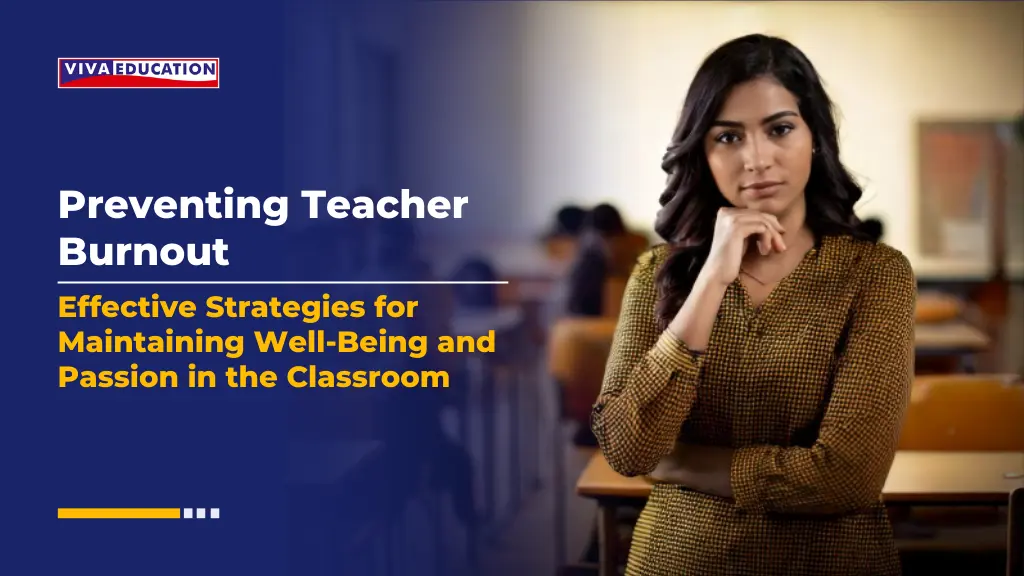Preventing Teacher Burnout: Effective Strategies for Maintaining Well-Being and Passion in the Classroom
- Teachers
- April 15, 2025
- Viva Education

Teaching can be one of the most fulfilling careers, but it’s also incredibly demanding. Many teachers begin their journey with passion and purpose, only to find themselves overwhelmed by long hours, mounting workloads, and the emotional toll of supporting so many young lives.
It’s no wonder that up to 74% of teachers report experiencing burnout, with many also struggling with stress, anxiety, and even depression. While there’s no instant solution, dedicating just a few focused minutes each day to targeted practices can help teachers build confidence, ease pressure, and rediscover the joy of teaching.
This article explores how integrating short, purposeful routines into a daily schedule can alleviate the strains of the classroom and support teachers in maintaining their well-being.
What is Teacher Burnout?
Teacher burnout is a state of emotional, physical, and mental exhaustion caused by prolonged or excessive work stress.
The World Health Organization (WHO) defines emotional exhaustion (energy depletion) as an occupational phenomenon. It encompasses three core dimensions: emotional cynicism/detachment (negativity toward students, colleagues, or the job) and reduced professional efficacy (diminished sense of accomplishment).
Unlike temporary stress, burnout is systemic and persistent, often exacerbated by excessive workloads, insufficient resources, disruptive student behavior, lack of autonomy, and inadequate administrative support.
Recognising the Red Flags of Teacher Burnout
Burnout can show up in various ways, depending on its severity. Some common signs include:
- Shifts in eating habits
- Noticeable weight changes
- Persistent fatigue
- Heightened anxiety or low mood
- Trouble sleeping
- Unexpected hair thinning
- Feeling unfulfilled in their role
- Difficulty relaxing during free time
If left unchecked, these symptoms may evolve into long-term depression and serious health issues.
Burnout can ripple into the classroom. Students under the care of overwhelmed teachers may receive less support, especially in subjects like maths, and often absorb their teacher’s stress. This can lead to declining academic performance and emotional struggles among learners.
The Leichtman Burnout Scale for Teachers
Burnout builds up in stages. The Leichtman Burnout Scale, developed by education researcher Kevin Leichtman, offers a simple four-stage framework that helps teachers identify where they are in the burnout process and take steps to protect their well-being.
Here’s a quick breakdown of the four levels:
- Level 1: Passionate but Overwhelmed
You love teaching, but the workload is starting to weigh you down. You may feel like you’re not doing enough, struggle with unhealthy coping habits, and have little time for hobbies outside school. - Level 2: Overwhelmed and Becoming Cynical
Stress increases, and you start feeling irritated and emotionally drained. Despite all your efforts, you don’t see positive results, and guilt starts to creep in. - Level 3: Cynical and Approaching Exhaustion
You feel isolated, doubt the system, and begin to shut down professionally. School feels like a place where nothing can improve, and you might avoid professional development altogether. - Level 4: Complete Exhaustion and Breakdown
Every part of your life feels affected. You’re constantly exhausted, even during holidays and may face physical health issues. At this point, teachers often consider either leaving the profession or finding a way to reignite their passion.
Knowing your stage can help you respond with the right strategies, whether seeking mentorship, reducing your workload, or prioritising your mental health. Recognising burnout early is the first step to reclaiming joy and balance in your teaching journey.
Strategies to Prevent and Overcome Teacher Burnout
- The Importance of Self-Awareness for Preventing Burnout
Regularly checking in with oneself to assess emotions, stress levels, and overall health is essential for preventing burnout.
Many teachers may not realise they are experiencing burnout until it’s too late. By learning about burnout and its signs, one can become more aware of their mental state and recognise when it’s time to step back.
This self-awareness reduces the guilt often associated with taking breaks and helps manage stress before it becomes overwhelming.
- Establish Clear Boundaries Between Work and Personal Life
Set specific work hours and avoid taking work home, especially on weekends. Establishing clear boundaries helps prevent the feeling of being constantly “on” and promotes mental relaxation.
- Practice Mindfulness and Meditation
Taking a few moments each day to practise mindfulness can make a world of difference. Simple activities like mindful breathing, doing a body scan, or reflecting on things you’re grateful for can help calm the mind, reduce stress, and improve focus, creating a more balanced mindset.
- Use Technology to Automate Repetitive Tasks
Using technology to automate repetitive tasks like grading, attendance, and feedback can help reduce the perceived burden of work.
Constantly thinking about the pending and growing pile of administrative duties can create increased mental stress, leading to feeling overwhelmed. The anticipation of these tasks can generate a sense of dread, contributing to burnout. By implementing educational tools and apps that handle these tasks efficiently, teachers can alleviate the mental load, free up valuable time, and focus more on meaningful student interactions, thereby reducing stress and preventing burnout.
Viva Education's test generator allows you to create test papers with minimal effort, saving you time and energy. Explore more about the Viva Test Generator in this video.
- Implement Flexible Lesson Planning
Imagine walking into your classroom and having the freedom to adjust lessons based on your students’ needs and energy. Flexible lesson planning allows you to tailor your teaching in real time, reducing the stress of sticking to a rigid schedule.
This approach relieves pressure by giving you the freedom to adapt lessons when necessary, helping you avoid burnout from trying to follow a fixed plan. Whether a topic needs more time or students need extra support, you can shift focus as needed, allowing you to teach more naturally, stay connected with your students, and reduce the mental burden of a strict routine.
- Set Realistic Expectations for Yourself
Avoid overloading yourself with unrealistic goals. Focus on achievable teaching targets and accept that perfection is not always attainable. Set small, incremental goals that build towards larger objectives without overwhelming yourself.
- Develop a Support Network
Create small groups or support networks within the teaching community to encourage open communication. These groups provide a safe space for teachers to share experiences, vent frustrations, and offer advice. Sometimes, simply speaking about the challenges you face can lift a significant emotional burden, reducing the feelings of isolation and burnout.
- Take Regular Digital Detox Breaks
After a full day of teaching, it’s easy to feel overwhelmed by the constant barrage of emails, messages, and notifications from social media and educational platforms. Taking regular digital detox breaks is an essential strategy for reducing burnout.
Spending time away from screens allows you to disconnect from work, giving your brain and body a much-needed rest. This break helps prevent mental fatigue, allowing you to recharge your energy and reset for the next day.
Disconnecting from screens can significantly improve one’s well-being, whether through engaging in outdoor activities, spending time with loved ones, or simply enjoying some quiet time.
- Engage in Professional Development That Feels Rewarding
Focusing on professional development that excites you can be a powerful tool in combating burnout. Instead of pursuing mandatory workshops or generic courses, choose areas that align with your passion and goals. You might explore new teaching methods that energise you, such as project-based learning or creative classroom strategies.
If technology excites you, diving deeper into ed-tech tools that improve your teaching experience can offer fresh insights and efficiency. Alternatively, focusing on strategies to enhance student well-being, such as mindfulness practices or social-emotional learning techniques, can reignite your passion for fostering a positive classroom environment.
Pursuing professional development in areas you care about brings a sense of growth and accomplishment, which helps you stay engaged and motivated.
What helps you recharge fastest?
- Adopt a Growth Mindset for Yourself
A growth mindset sees challenges as opportunities to improve rather than roadblocks. When things don’t go as planned, instead of thinking, “I can’t do this,” try asking yourself, “How can I make this better?” or “What can I learn from this?”
These small shifts in thinking can make a big difference. Rather than labelling situations as failures, a growth mindset encourages you to look for solutions and figure out how to move forward. Unlike a fixed mindset, which sees setbacks as a sign of inability, a growth mindset focuses on learning and growing, helping you stay motivated and avoid burnout. It’s about embracing the journey, not just the destination.
Supporting Teachers to Combat Burnout
Schools can make a real difference in helping teachers tackle burnout by lightening their workload and offering more support. This means reducing unnecessary admin tasks, providing access to mental health resources, and encouraging a healthy work-life balance.
Schools can also create a supportive environment where teachers collaborate, share ideas, and have the resources to succeed. Recognizing teachers for their hard work and offering fair pay can boost morale, while a positive school culture makes teachers feel valued.
Tackling student behavior issues early on and fostering opportunities for reflection and self-care can go a long way in reducing stress. By making these changes, schools can help teachers feel supported, empowered, and ready to give their best daily.
Final Thoughts
In summary, teacher burnout is a serious issue affecting educators emotionally, physically, and mentally, often leading to exhaustion and detachment. However, by implementing small, intentional practices such as setting boundaries, embracing mindfulness, automating repetitive tasks, and engaging in professional development that excites them, teachers can regain balance and reignite their passion for teaching.
The key to overcoming burnout is self-awareness, realistic expectations, and the creation of a supportive and professional environment. Remember, when teachers care for themselves, they can better care for their students. Ultimately, teaching should remain a fulfilling and rewarding journey, and with the right tools and mindset, educators can continue to thrive in their careers.
Frequently Asked Questions:
1. How can teachers reduce daily stress?
Simple habits like setting boundaries, short mindfulness breaks, flexible planning, and digital detox can reduce stress and improve focus.
2. What are the early signs of teacher burnout?
Common signs include constant fatigue, irritability, sleep issues, low motivation, and feeling overwhelmed by routine tasks.
3. What is the Leichtman Burnout Scale?
It’s a four-level scale that helps teachers identify if they’re “overwhelmed,” “cynical,” or “exhausted” so they can take the right steps to recover.
4. How can teachers stay motivated in the classroom?
Focus on rewarding professional development, creative teaching methods, and small wins that remind you why you love teaching.
5. How do schools help prevent teacher burnout?
Schools can reduce burnout by cutting unnecessary admin work, offering mental health support, and creating a positive, collaborative culture.
>> Please Share



